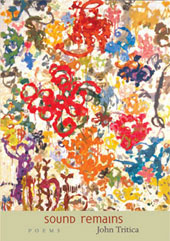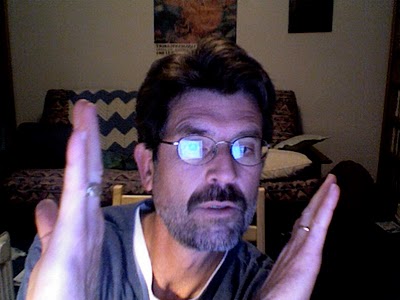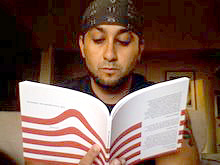
| Jacket 40 — Late 2010 | Jacket 40 Contents | Jacket Homepage | Search Jacket |
This piece is about 3 printed pages long.
It is copyright © Craig Santos Perez and Jacket magazine 2010. See our [»»] Copyright notice.
The Internet address of this page is http://jacketmagazine.com/40/r-tritica-rb-perez.shtml
John Tritica
Sound Remains
reviewed by
Craig Santos Perez
Chax Press, 2008. $14. 83 pp. Paper. ISBN: 978–0925904-59–1.

1
Throughout Sounds Remains, I was drawn in by Tritica’s perceptive and lyrical observations of the material and immaterial worlds:
2
She walks across Central
purple dress, ink in wind. (13)
Out of the jaws of expanding vacany
the plenum’s light release. (16)
3
These two couplets, from different sections of the serial poem “Lift off Leaning,” capture two very different modes that Tritica traverses. And they don’t necessarily intersect; instead, we find ourselves at the edges of their narrative and semantic distances. Tritica writes at what he calls “the active edge” of the world and sensation: “the edge of words / where they cast off into over / around through the partial” (33).
4
We might claim, also, that Tritica writes at the edge of form: some poems exist individually and others develop serially; some poems remain left-justified while others occupy the center of the page. To me, this variety creates formal texture and keeps our expectations open and improvisational.

John Tritica
5
One of my favorite sentences, from “Shoring the Tide,” reads: “Waves delete / completion, the continual conceived” (35). The deferral of closure caused by waves of poetic perception allows Tritica’s work to remain continual and partial. Many statements — like the one above — shore into the main theme of its poem while commenting on poetry itself. From “Island Variations”:
6
We pass over the pavement
not to complete what’s seen
Toward solace among leaves and early chill.
A partial content shapes, funnels.
Or by deed, rock vein startles
amused identities.
When I scan meridians, enclosures,
cover horizons.
Canada geese like an unclasped necklace
in the sky. (39)
7
“A partial content shapes, funnels” describes how narrative operates in Sound Remains. As if to say what remains of experience is the sound at the edge of words and forms. Narrative becomes funneled through vibrant paratactic distances — vibrant because they “extend the inexpressible” (75).
8
Improvisation and intertextuality also create further tensions in Tritica’s work. “Improvisation Beginning with Lines by Rosmarie Waldrop” begins with italicized lines (which we learn at the end of the poem are from Waldrop’s Reproduction of Profiles) and moves to “played calligraphy / that spells viscera” and eventually ends in a kind of improvised “tongue’s fugue”: “screen the angles / distances affect ascent / measure slant meridians” (46). In another serial poem, “All Matter is Encounter,” we read: “Improvisation in attention to the sound or color that ignites” (69).
9
Besides the strangeness and mysteriousness of its funneled narrative, Sound Remains manages to harmonize its poetry with its theory, much like Wallace Stevens. Tritica writes: “Organize the words / and watch them revolt” (58); “Organize the stanzas, and watch the method revolt” (71); and “Shape line briefly so / syllables earn their sound” (72). Sound Remains illustrates and embodies these imperatives and proves, in various ways, that “To write / is to consult your faculties and expand the enclosures” (71).

Craig Santos Perez
Craig Santos Perez is a co-founder of Achiote Press (www.achiotepress.com) and author of from unincorporated territory [hacha] (Tinfish Press, 2008). He blogs at craigsantosperez.wordpress.com.